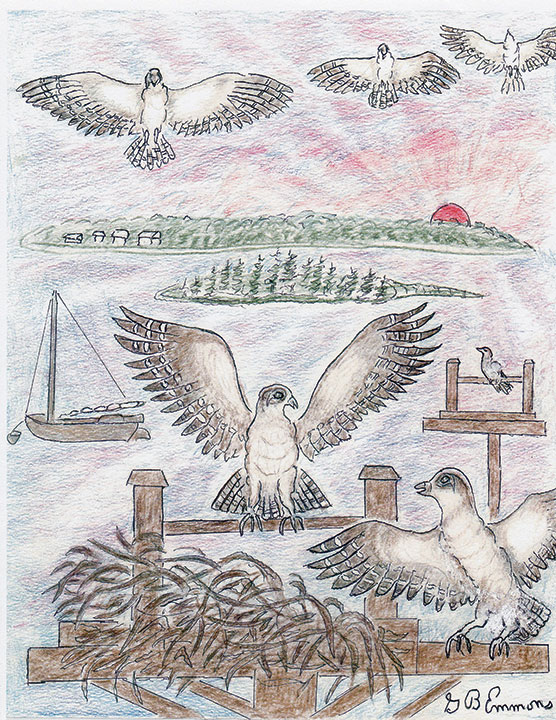My previous articles have featured previous migration phenomena not previously known until modern electronic tracking chips have been attached to Monarch butterflies, hummingbirds, great blue herons, and snow geese. However, amazingly, now, just as ospreys are ready to begin their autumn migration in September, we have incredible scientific information about how young ospreys must find their way thousands of miles on their own without their parents.
Most birdwatchers for years believed that coastal fledglings grew up to migrate as a family together like the iconic seasonal ‘V’ formation of Canada geese. With young ospreys, when they leave home for the first time, they are flying solo, completely without parental guidance.
My illustration of the nesting towers just behind our house on the coast of Little Bay in Fairhaven shows two parents encouraging three young ones to unfold, flap their wings, and launch their first flight into the air.
According to a nearby neighbor observing, this actual lesson in flight occurred during the first week of July, much earlier than I expected. The mother osprey had been so busy raising them by teaching them to feed on fish that their father had been able to catch. Both parents work so hard without a day’s rest they both lose approximately 15 percent of their body mass in this critical family timeframe. Subsequently, when their young have finally polished off their flying and fish-catching expertise, when that time comes, they both leave the nest and their offspring behind.
The incredible journey for their offspring soon enough starts them out to a destination thousands of miles away on a long-winded journey guided by the position of the sun on the horizon, as well as daily vibrations of earthly magnetic field to tell them direction along the coastal line of the Atlantic flyway.
Recently, a clear electronic tracking record showed that a young female passed Martha’s Vineyard in mid-September of last year and two weeks later reached the shores of French Guiana, where she chose to spend the entire winter before starting out to return here in the spring.
Before the present migration is already underway, the local population had received a boost from the spring herring runs up our local rivers, with an abundance of fish for feeding the present population to thrive. The Buzzards Bay Coast Guard Auxiliary has also worked for years to monitor and improve water quality for their habitat, as well as provide nesting box towers to attract local residence.
As you read this, perhaps the most incredible link is the unbroken chain of annual survival for the new generation in the journey of autumn migration just over the horizon. May we wish them an amazing instinct of navigation to find their way, as well as a safe return for another year of an even better round trip.
By George B. Emmons
